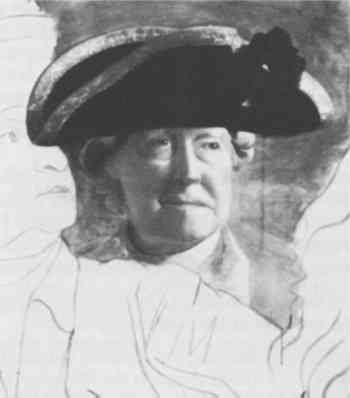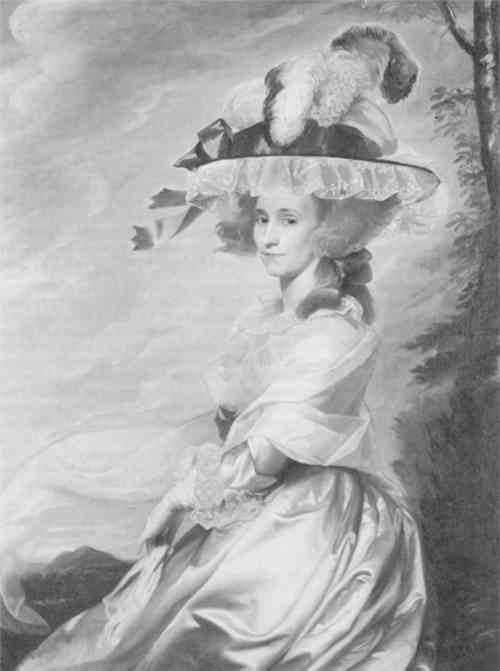JOHN SINGLETON COPLEY'S PORTRAITS: A TECHNICAL STUDY OF THREE REPRESENTATIVE EXAMPLESJ. William Shank
5 ENGLISH WORKS (after 1774)WHEN COPLEY LEFT AMERICA in 1774 to begin the Grand Tour of the continent and eventually to settle in London, a whole new world of art opened up to him. In Italy, before the works of the great masters of the Renaissance, the American artist began to ponder questions that he had never considered before, regarding the possibilities of applying paint to canvas. He was particularly struck by the basic differences in appearance between his own works and those of Titian, and he questioned the techniques that came to make them look as they did. Copley speculates on the preparation of Titian's canvases in this letter from Rome, dated 14 March 1775:
Titian's medium, too, impressed Copley as something quite dissimilar to the pigments ground in oil to which he was accustomed.
He suggests experiments to Henry Pelham to simulate Titian's layered paintings:
The concept of glazing to create form and colour was one quite alien to Copley, whose paints were applied in so straightforward a manner. He marvels at Titian's Venus of Urbino in a letter from Parma, 25 June 1775:
He advises his half-brother to reconsider the use of undiluted oil colors, in the same letter: and to try the following procedure for executing a Titianesque picture:
Copley's initial fascination with the technique of the old masters seems to have remained, in large part, theoretical. Prown suggests,“ … although he planned to experiment with this (in reference to above letter from Parma), he did not plan to spend much time trying to imitate another painter, especially since Reynolds, West and others had wisely told him it would be a mistake to alter his style.”32 Ironically, it was the style of these same English artists which would have the most marked effect upon Copley's work after he settled in London in 1775. They proved, in some instances, to be poor examples for Copley, in terms of experimentation with untested painting materials and techniques. As preparation for his English paintings, which often involved complex multifigural compositions, Copley learned to sketch from life: he writes to Henry Pelham from Paris, 2 September 1774:
A method of transferring sketches to canvas became necessary; this description is of Copley's approach to the creation of the Ascension of 1775:
While no actual underdrawings appear in any of the portraits in this study, another painting in the Fogg's collection shows Copley's layout of a facial composition with warm, thinly applied outlines, probably of the bistre he mentions above. The sketch of Major General August de la Motte, painted in 1787 for The Siege of Gibraltar, shows that a very linear treatment of the basic composition exists under the fully modelled forms (Fig. 4).
The undesirable elements that crept into the physical make-up of Copley's pictures in England were most likely inspired by the technique of Benjamin West and Joshua Reynolds, the latter a notorious experimenter with painting materials. Copley notes:
A similar mixture could be used as a “method to give richness to your Colours.”36 A contemporary biographer of Reynolds, Marchi, notes that the artist used megilp (a mixture of mastic resin, turpentine and linseed oil, similar to the one described above) to serve as a tint. It often yellowed and had to be removed within months of its application.37 Reynolds was also known to mix incompatible pigments such as orpiment and lead white, and to use fugitive colors such as lakes and carmines.38 Other additives such as driers and wax were mixed with oil paints, and several media were “wrecklessly superimposed.”39 Copley's English works show signs of similar inclusions in the paint layer. A portrait of John Adams, painted in 1783 (and now in the Harvard University Portrait collection), examined and treated by the author in 1983, showed the characteristic signs of bitumen or other resinous inclusions in the paint layer. 5.1 MRS. DANIEL DENISON ROGERS (1783)The portrait of Mrs. Rogers (born Abigail Bromfield; she was the artist's stepniece) is a fine example of Copley's portrait style in the 1780's (Fig. 5). The vibrant depiction of a young woman in a satin gown and feathered hat is alive with motion around the calm stare of the sitter. Copley's brushwork is lively and spontaneous. The probability that the artist had picked up a great deal of speed in his work is evidenced by the “halo” effect around, for instance, the hat ribbons where they meet the sky. Copley did not take the time to carefully fill in the gaps between the colors. Pentimenti are also in evidence.
5.1.1 SUPPORT:The original canvas is linen of a fairly fine, if irregular, plain weave, with about fifteen threads per centimeter. 5.1.2 GROUND:The ground layer clearly contains lead, judging from the appearance of the canvas in the x-radiograph. Examination with both the polarizing microscope and the scanning electron microscope confirms the presence of lead white, along with calcite. 5.1.3 PAINT LAYER:Cross-section analysis brings to light some interesting structural features of Mrs. Rogers. A sample taken from the orange sunset shows a layer of light blue/green underpainting beneath the surface color, the same color, apparently, which shows through at the juncture of the hat ribbons and the sky. A cross-section taken from a white highlight on the tree trunk behind Mrs. Rogers reveals an unusually complex structure of layering of paint. The white highlight is painted over the brown of the tree, the blue/green underpainting, and the white ground. Above the white highlight is a dark brown resinous glaze (perhaps bitumen) which has been used as a “softening” or atmospheric effect on this formal background element, evidently so that the highlight would not appear too bright. Whether or not Copley mixed meglip or other resinous elements with the paints of this portrait remains a question. It should be noted, however, that ultraviolet fluorescence reveals a surprisingly extensive pattern of wide craquelure (since inpainted) quite foreign to Copley's American works like Nicholas Boylston. BINDING MEDIUM: The medium appears to be traditional oil, probably poppy or walnut oil, apparently medium-rich. PIGMENTS: The palette employed by Copley in this English portrait seems to be virtually identical to the one he used in America. Pigments identified, or estimated to be present, in the portrait of Mrs. Rogers include: lead white, calcite, vermilion, (hematite/red ochre?), Naples yellow/yellow ochre, charcoal black. Unidentified red, yellow, and blue stains were also observed. (Please see Table 3.) Table 3 MRS. DANIEL DENISON ROGERS, Fogg Art Museum, 1979.179 50⅛″ (h) � 40″ (w); 127 cm (h) � 102 cm (w) |

